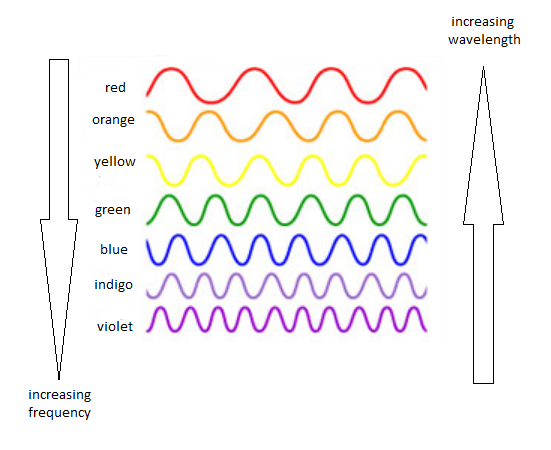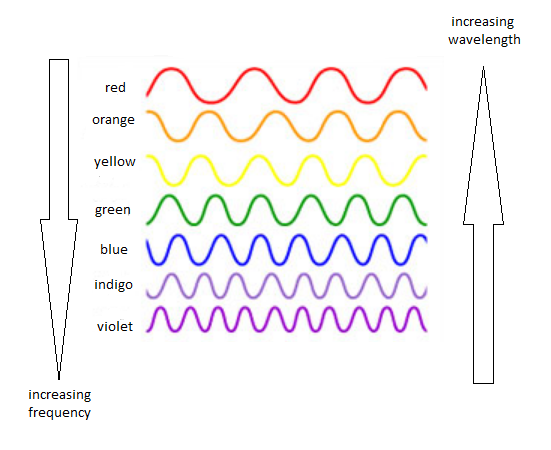
Basic Chemistry
6th Edition
ISBN: 9780134878119
Author: Timberlake, Karen C. , William
Publisher: Pearson,
expand_more
expand_more
format_list_bulleted
Concept explainers
Question
Chapter 5.2, Problem 19PP
(a)
Interpretation Introduction
Interpretation: The photon with the greater energy among green light or yellow light should be identified.
Concept introduction:
Comparison of wavelength and frequency of radiations in visible spectrum.

(b)
Interpretation Introduction
Interpretation: The photon with the greater energy among red light or blue light should be identified.
Concept introduction:
Comparison of wavelength and frequency of radiations in visible spectrum.

Expert Solution & Answer
Want to see the full answer?
Check out a sample textbook solution
Students have asked these similar questions
MISSED THIS? Read Section 19.9 (Pages 878-881); Watch IWE 19.10
Consider the following reaction:
CH3OH(g)
CO(g) + 2H2(g)
(Note that AG,CH3OH(g) = -162.3 kJ/mol and AG,co(g)=-137.2 kJ/mol.)
Part A
Calculate AG for this reaction at 25 °C under the following conditions:
PCH₂OH
Pco
PH2
0.815 atm
=
0.140 atm
0.170 atm
Express your answer in kilojoules to three significant figures.
Ο ΑΣΦ
AG = -150
Submit
Previous Answers Request Answer
□?
kJ
× Incorrect; Try Again; 2 attempts remaining
Calculate the free energy change under nonstandard conditions (AGrxn) by using the following relationship:
AGrxn = AGrxn + RTInQ,
AGxn+RTInQ,
where AGxn is the standard free energy change, R is the ideal gas constant, T is the temperature in kelvins, a
is the reaction quotient.
Provide Feedback
Next >
Identify and provide a brief explanation of Gas Chromatography (GC) within the context of chemical analysis of food. Incorporate the specific application name, provide a concise overview of sample preparation methods, outline instrumental parameters and conditions ultilized, and summarise the outcomes and findings achieved through this analytical approach.
Identify and provide a concise explanation of the concept of signal-to-noise ratio (SNR) in the context of chemical analysis. Provide specific examples.
Chapter 5 Solutions
Basic Chemistry
Ch. 5.1 - What is meant by the wavelength of UV light?Ch. 5.1 - How are the wavelength and frequency of light...Ch. 5.1 - What is the difference between "white” light and...Ch. 5.1 - Prob. 4PPCh. 5.1 - Ultraviolet radiation (UVB) used to treat...Ch. 5.1 - AM radio waves have a frequency of 8105s1, whereas...Ch. 5.1 - If orange light has a wavelength of 6105cm, what...Ch. 5.1 - A wavelength of 850 nm is used for fiber-optic...Ch. 5.1 - Prob. 9PPCh. 5.1 - Prob. 10PP
Ch. 5.1 - Prob. 11PPCh. 5.1 - Place the following types of electromagnetic...Ch. 5.1 - Prob. 13PPCh. 5.1 - Place the following types of electromagnetic...Ch. 5.2 - What feature of an atomic spectrum indicates that...Ch. 5.2 - How can we explain the distinct lines that appear...Ch. 5.2 - Prob. 17PPCh. 5.2 - Prob. 18PPCh. 5.2 - Prob. 19PPCh. 5.2 - Prob. 20PPCh. 5.3 - Describe the shape of each of the following...Ch. 5.3 - Describe the shape of each of the following...Ch. 5.3 - Match statements 1 to 3 with a to d: 1. They have...Ch. 5.3 - Match statements 1 to 3 with a to d: 1. They have...Ch. 5.3 - Prob. 25PPCh. 5.3 - Indicate the number of each in the following: a....Ch. 5.3 - Prob. 27PPCh. 5.3 - Prob. 28PPCh. 5.4 - Compare the terms electron configuration and...Ch. 5.4 - Compare the terms orbital diagram and electron...Ch. 5.4 - Draw the orbital diagram for each of the...Ch. 5.4 - Draw the orbital diagram for each of the...Ch. 5.4 - Prob. 33PPCh. 5.4 - Write the complete electron configuration for each...Ch. 5.4 - Prob. 35PPCh. 5.4 - Prob. 36PPCh. 5.4 - Prob. 37PPCh. 5.4 - Prob. 38PPCh. 5.4 - Prob. 39PPCh. 5.4 - Give the symbol of the element that meets the...Ch. 5.5 - Use the sublevel blocks on the periodic table to...Ch. 5.5 - Use the sublevel blocks on the periodic table to...Ch. 5.5 - Use the sublevel blocks on the periodic table to...Ch. 5.5 - Use the sublevel blocks on the periodic table to...Ch. 5.5 - Prob. 45PPCh. 5.5 - Use the periodic table to give the symbol of the...Ch. 5.5 - Prob. 47PPCh. 5.5 - Use the periodic table lo give the symbol of the...Ch. 5.5 - Prob. 49PPCh. 5.5 - Prob. 50PPCh. 5.6 - What do the group numbers from IA (1) to 8A (18)...Ch. 5.6 - Prob. 52PPCh. 5.6 - Write the group number using both A/B and 1 to 18...Ch. 5.6 - Write the group number using both A/B and 1 to 18...Ch. 5.6 - Write the valence electron configuration for each...Ch. 5.6 - Prob. 56PPCh. 5.6 - Prob. 57PPCh. 5.6 - Indicate the number of valence electrons in each...Ch. 5.6 - Prob. 59PPCh. 5.6 - Prob. 60PPCh. 5.6 - Prob. 61PPCh. 5.6 - Prob. 62PPCh. 5.6 - Prob. 63PPCh. 5.6 - Select the element in each pair with the higher...Ch. 5.6 - Prob. 65PPCh. 5.6 - Prob. 66PPCh. 5.6 - Prob. 67PPCh. 5.6 - Prob. 68PPCh. 5.6 - Prob. 69PPCh. 5.6 - Prob. 70PPCh. 5.6 - Prob. 71PPCh. 5.6 - Prob. 72PPCh. 5.6 - Which statements completed with a to e will be...Ch. 5.6 - Which statements completed with a to e will be...Ch. 5.6 - Prob. 75PPCh. 5.6 - a. What is the atomic number of Te? b. How many...Ch. 5 - The chapter sections to review are shown in...Ch. 5 - Prob. 78UTCCh. 5 - Prob. 79UTCCh. 5 - Prob. 80UTCCh. 5 - The chapter sections to review are shown in...Ch. 5 - The chapter sections to review are shown in...Ch. 5 - The chapter sections to review are shown in...Ch. 5 - Prob. 84UTCCh. 5 - Prob. 85APPCh. 5 - Prob. 86APPCh. 5 - Prob. 87APPCh. 5 - Prob. 88APPCh. 5 - Prob. 89APPCh. 5 - Prob. 90APPCh. 5 - Prob. 91APPCh. 5 - Prob. 92APPCh. 5 - a. How many 3d electrons are in Fe? (5.4) b. How...Ch. 5 - a. How many 4d electrons are in Cd? (5.4) b. How...Ch. 5 - Write the abbreviated electron configuration and...Ch. 5 - Prob. 96APPCh. 5 - What do the elements Ca, Sr, and Ba have in common...Ch. 5 - Prob. 98APPCh. 5 - Prob. 99APPCh. 5 - Name the element that corresponds to each of the...Ch. 5 - Prob. 101APPCh. 5 - Prob. 102APPCh. 5 - Select the more metallic element in each pair....Ch. 5 - Select the more metallic element in each pair....Ch. 5 - Of the elements Na, P, CI, and F, which (5.6) a....Ch. 5 - Of the elements K, Ca, Br, and Kr, which (5.6) a....Ch. 5 - Prob. 107APPCh. 5 - Prob. 108APPCh. 5 - Prob. 109CPCh. 5 - Prob. 110CPCh. 5 - Prob. 111CPCh. 5 - Prob. 112CPCh. 5 - Prob. 113CPCh. 5 - The following problems are related to the topics...Ch. 5 - The following problems are related to the topics...Ch. 5 - The following problems are related to the topics...
Knowledge Booster
Learn more about
Need a deep-dive on the concept behind this application? Look no further. Learn more about this topic, chemistry and related others by exploring similar questions and additional content below.Similar questions
- Identify and provide a concise explanation of a specific analytical instrument capable of detecting and quantifying trace compounds in food samples. Emphasise the instrumental capabilities relevant to trace compound analysis in the nominated food. Include the specific application name (eg: identification and quantification of mercury in salmon), outline a brief description of sample preparation procedures, and provide a summary of the obtained results from the analytical process.arrow_forwardIdentify and provide an explanation of what 'Seperation Science' is. Also describe its importance with the respect to the chemical analysis of food. Provide specific examples.arrow_forward5. Propose a Synthesis for the molecule below. You may use any starting materials containing 6 carbons or less (reagents that aren't incorporated into the final molecule such as PhзP do not count towards this total, and the starting material can have whatever non-carbon functional groups you want), and any of the reactions you have learned so far in organic chemistry I, II, and III. Your final answer should show each step separately, with intermediates and conditions clearly drawn. H3C CH3arrow_forward
- State the name and condensed formula of isooxazole obtained by reacting acetylacetone and hydroxylamine.arrow_forwardState the name and condensed formula of the isothiazole obtained by reacting acetylacetone and thiosemicarbazide.arrow_forwardProvide the semi-developed formula of isooxazole obtained by reacting acetylacetone and hydroxylamine.arrow_forward
- Given a 1,3-dicarbonyl compound (R1-CO-CH2-CO-R2), indicate the formula of the compound obtaineda) if I add hydroxylamine (NH2OH) to give an isooxazole.b) if I add thiosemicarbazide (NH2-CO-NH-NH2) to give an isothiazole.arrow_forwardAn orange laser has a wavelength of 610 nm. What is the energy of this light?arrow_forwardThe molar absorptivity of a protein in water at 280 nm can be estimated within ~5-10% from its content of the amino acids tyrosine and tryptophan and from the number of disulfide linkages (R-S-S-R) between cysteine residues: Ε280 nm (M-1 cm-1) ≈ 5500 nTrp + 1490 nTyr + 125 nS-S where nTrp is the number of tryptophans, nTyr is the number of tyrosines, and nS-S is the number of disulfide linkages. The protein human serum transferrin has 678 amino acids including 8 tryptophans, 26 tyrosines, and 19 disulfide linkages. The molecular mass of the most dominant for is 79550. Predict the molar absorptivity of transferrin. Predict the absorbance of a solution that’s 1.000 g/L transferrin in a 1.000-cm-pathlength cuvet. Estimate the g/L of a transferrin solution with an absorbance of 1.50 at 280 nm.arrow_forward
- In GC, what order will the following molecules elute from the column? CH3OCH3, CH3CH2OH, C3H8, C4H10arrow_forwardBeer’s Law is A = εbc, where A is absorbance, ε is the molar absorptivity (which is specific to the compound and wavelength in the measurement), and c is concentration. The absorbance of a 2.31 × 10-5 M solution of a compound is 0.822 at a wavelength of 266 nm in a 1.00-cm cell. Calculate the molar absorptivity at 266 nm.arrow_forwardHow to calculate % of unknown solution using line of best fit y=0.1227x + 0.0292 (y=2.244)arrow_forward
arrow_back_ios
SEE MORE QUESTIONS
arrow_forward_ios
Recommended textbooks for you


 World of Chemistry, 3rd editionChemistryISBN:9781133109655Author:Steven S. Zumdahl, Susan L. Zumdahl, Donald J. DeCostePublisher:Brooks / Cole / Cengage Learning
World of Chemistry, 3rd editionChemistryISBN:9781133109655Author:Steven S. Zumdahl, Susan L. Zumdahl, Donald J. DeCostePublisher:Brooks / Cole / Cengage Learning Introductory Chemistry: A FoundationChemistryISBN:9781337399425Author:Steven S. Zumdahl, Donald J. DeCostePublisher:Cengage LearningChemistry: Matter and ChangeChemistryISBN:9780078746376Author:Dinah Zike, Laurel Dingrando, Nicholas Hainen, Cheryl WistromPublisher:Glencoe/McGraw-Hill School Pub Co
Introductory Chemistry: A FoundationChemistryISBN:9781337399425Author:Steven S. Zumdahl, Donald J. DeCostePublisher:Cengage LearningChemistry: Matter and ChangeChemistryISBN:9780078746376Author:Dinah Zike, Laurel Dingrando, Nicholas Hainen, Cheryl WistromPublisher:Glencoe/McGraw-Hill School Pub Co Introductory Chemistry: An Active Learning Approa...ChemistryISBN:9781305079250Author:Mark S. Cracolice, Ed PetersPublisher:Cengage Learning
Introductory Chemistry: An Active Learning Approa...ChemistryISBN:9781305079250Author:Mark S. Cracolice, Ed PetersPublisher:Cengage Learning



World of Chemistry, 3rd edition
Chemistry
ISBN:9781133109655
Author:Steven S. Zumdahl, Susan L. Zumdahl, Donald J. DeCoste
Publisher:Brooks / Cole / Cengage Learning

Introductory Chemistry: A Foundation
Chemistry
ISBN:9781337399425
Author:Steven S. Zumdahl, Donald J. DeCoste
Publisher:Cengage Learning

Chemistry: Matter and Change
Chemistry
ISBN:9780078746376
Author:Dinah Zike, Laurel Dingrando, Nicholas Hainen, Cheryl Wistrom
Publisher:Glencoe/McGraw-Hill School Pub Co

Introductory Chemistry: An Active Learning Approa...
Chemistry
ISBN:9781305079250
Author:Mark S. Cracolice, Ed Peters
Publisher:Cengage Learning
Quantum Mechanics - Part 1: Crash Course Physics #43; Author: CrashCourse;https://www.youtube.com/watch?v=7kb1VT0J3DE;License: Standard YouTube License, CC-BY